‘Here’s Looking at You Kid’ – 75 Years of Casablanca
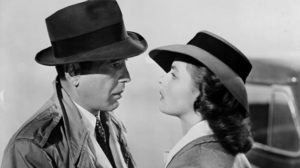
When one surveys the history of Hollywood cinema to date, there are surely few films as iconic and as universally popular as Casablanca which celebrates the 75th anniversary of its initial theatrical release in November 2017. Proving that some of the very best screen productions come about through chance and happy circumstance, Casablanca has a lasting popularity and influence which befits its much beloved and classic status. Premiering on November 26th, 1942 (to coincide with the Allied invasion of North Africa), the film pretty much represented a run-of-the-mill studio effort by Warner Brothers with some attractive names and a story line which seemed apt and pertinent given the context of its time. To put it bluntly, nobody expected it to attain the lofty position it now enjoys 75 years later. The film has quite rightly been celebrated as a treasure of old Hollywood. The famous film critic Roger Ebert summed up its reputation appropriately when he suggested that it may well be on more lists of the greatest films of all time than any other. From a personal point of view, it firmly sits on this own reviewer’s top ten favourites. I could watch Bogie and Bergman et al time after time. As time goes by, Casablanca really seems to improve with each and every viewing.
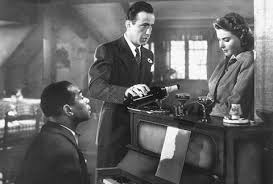
Based on the unproduced stage play Everybody Comes to Rick’s, which was written by Murray Burnett and Joan Alison in 1940, Casablanca opens with a solemn voice-over explaining the current situation in the Moroccan city. Many refugees reside there desperately hoping to obtain exit visas to the New World. The streets and bars are awash with those who dare to dream and those who prey on their precarious situations. The closest many come to realising their goal of freedom is expressed in the shot as they watch a plane depart for Lisbon. The film’s narrative trajectory begins properly as we learn that two German couriers carrying such precious exit visas have been murdered. The usual suspects are to be rounded up as a demonstration of force by officials of Vichy France. In an early scene, one of these suspects is shot in front of a poster of Philippe Petain as he attempts to evade the authorities.
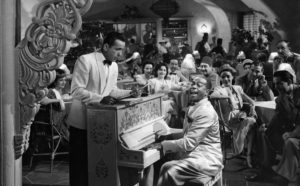
We catch our first glimpse of Rick’s Cafe Americain as a young woman stares dreamily at the departing plane for Lisbon. ‘Perhaps tomorrow we’ll be on the plane,’ she whispers to her husband. In an ensuing scene, the chief of police, Captain Louis Renault (Claude Rains), greets Major Heinrich Strasser (Conrad Veidt) of the Third Reich as the latter arrives in Casablanca. Appearing to be servile at first, Renault assures Strasser that the individual who murdered the German couriers will be taken into custody later that evening at Rick’s. When quizzed as to what type of establishment Rick’s is, Renault simply replies, ‘Everybody comes to Rick’s,’ in a playful reference to the original play. Shot almost entirely in the studio, aficionados of the film might be interested to learn that this was the one and only scene which was filmed in a location other than the Warner Brothers lot – Van Nuys Airport to be precise, which is located in the San Fernando Valley, California.
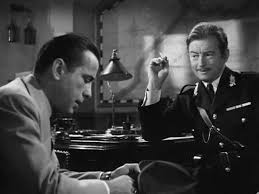
Cinema has delivered some memorable protagonists over the last century or so, but few rank as high as Humphrey Bogart’s Rick Blaine, and even fewer have been accorded so many memorable lines of dialogue. But Blaine is presented to us in the first instance as a rather self-serving businessman who, in his own words, sticks his neck out for nobody. He refuses to help Peter Lorre’s Signor Ugarte who, as it transpires, is the person sought by the police in connection with the death of the German couriers. In a key scene Ugarte has entrusted the exit visas to Rick believing that he will not give them up to the enemy. Following Ugarte’s subsequent arrest, Rick finds himself in the unique position of possessing these visas which could provide him with safe passage to the country of his birth and upbringing. Renault, who is on friendly terms with Rick, perceives such an innate longing in the character whom he believes to be a ‘patriot at heart.’ When Rick dismisses such a notion, Renault reminds him that he once ran guns to Ethiopia and, on another occasion, fought on the Loyalist side in the Spanish Civil War. The chemistry in this particular scene between Bogart and Rains (and elsewhere during the film) is one of the many joys of Casablanca. When Bogart remarks that he came to Casablanca for the waters, Rains points out that they are in the middle of the desert. ‘I was misinformed,’ Bogart replies without batting an eyelid.
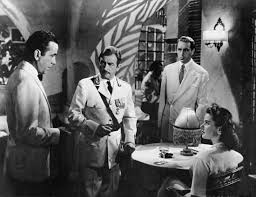
The pivotal drama of Casablanca begins, of course, with the introduction of Victor Laszlo (Paul Henreid) and his female companion Ilsa Lund (Ingrid Bergman). Laszlo has already been previously mentioned as a leader of the Czech Resistance who has survived a concentration camp and is a constant thorn in the side of the Nazis. Laszlo has come to Casablanca in the hope of obtaining an exit visa for himself and Ilsa. High-minded and intrepid to the nth degree, he wishes to carry on his work in America where he can further mobilise the fight against the Nazis. The famous scene in which Rick and Ilsa are reunited is also the occasion for one of the misquotations which have surrounded the film. At no point does Ilsa actually tell Sam (Dooley Wilson) to ‘Play It Again Sam.’ Nor does the line surface in the following scene in which a distraught and inebriated Rick recalls his time in Paris with Ilsa. It’s a wonderful moment as Rick and Ilsa’s eyes meet; their expressions speak a thousand words. We are informed that they once knew each other, but there’s little doubting the fact that there is more than a casual acquaintance here. This much is subsequently confirmed in the Parisian flashback scenes.
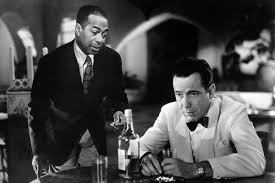
The screenplay by twin brothers Julius J. and Philip G. Epstein and Howard Koch (with contributions by uncredited others) is deservedly ranked as one of the greatest in all of Hollywood cinema and I have little argument with this. Just consider, if you will, the many unforgettable lines of dialogue which litter the Casablanca script. The American Film Institute’s list of 100 movie quotes includes six in total from the 1942 film. That’s more than any other single film. ‘Here’s looking at you kid’ is the highest ranked of these occupying position number 5 on the aforementioned list. For the record, the origins of it have been attributed to Bogart himself who made such a remark as he taught Bergman how to play poker in between takes. ‘Of all the gin joints in all the towns in all the world, she walks into mine,’ a drunken Blaine observes as he bitterly reminisces about their time together in pre-war Paris. When the Germans invade France and overrun their army, Rick, Ilsa and Sam plan to depart the capital on a train bound for Marseille. Rick suggests they get married, but she reacts uncomfortably to this and does not turn up at the station as arranged. We subsequently learn that Ilsa is married to Victor and had been even as she knew Rick in Paris (she had been led to believe that Laszlo had died at the hands of the Nazis).
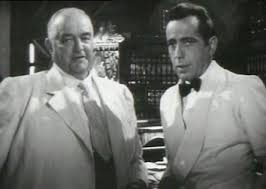
Apart from the screenplay, another notable facet which provides Casablanca with its timeless quality is the stellar cast of principal players and supporting actors. Although he had made a decisive breakthrough in his career by way of 1941’s The Maltese Falcon, this was truly the film which cemented Bogart’s standing in the industry and is one of his very best performances. Two other actors who appeared with him in the John Huston film of the Dashiell Hammett novel from the previous year also feature in Casablanca – Peter Lorre as the unfortunate Ugarte and the unmistakable Sydney Greenstreet as Signor Ferrari (who runs the rival Blue Parrot bar). Other memorable turns during the course of the film include Dooley Wilson as Sam, S.Z. Sakall as Carl the waiter, Leonid Kinskey as Sascha the Russian bartender, Madeleine LeBeau as Yvonne (Rick’s ex-girlfriend), Curt Bois as the inveterate pickpocket and Joy Page as the young Bulgarian refugee who beseeches Rick to assist her and her husband (which he does in one of the film’s most heartwarming moments). Conrad Veidt – who plays Strasser – was a prominent German actor of the era who fled the country with his Jewish wife shortly after the Nazis came to power. The most-highly paid actor in the Casablanca cast, Veidt, sadly, did not live to see its reputation flourish – he died in April 1943, a mere three months after the film’s general release. Paul Henreid also fares well as Victor Laszlo although legend has it that he did not get on well with the rest of the cast. Ingrid Bergman (who, apparently, referred to Henreid as a ‘prima donna’) is herself suitably radiant and emotionally torn in the role of Ilsa. Roger Ebert, in this latter regard, refers to her as ‘luminous’ which certainly draws no quarrel from me.
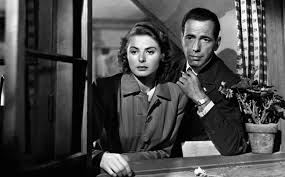
In terms of a pervading theme which informs the film, Casablanca is concerned with the individual’s place with respect to events which are bigger than himself and how he eventually chooses to make a personal sacrifice for the greater good. Rick holds the much-sought-after exit visas which can provide Victor Laszlo with his passage to America. Appealing to Rick’s dormant patriotic fervour, Laszlo (like Renault) reminds the reluctant hero of his past and how he has previously fought on the losing side. Rick refuses to hand over the visas citing Ilsa as the reason for doing so and, in the process, reveals to Laszlo that he knows about their secret marriage. In the famous La Marseillaise scene which takes place in the bar, however, we do get a hint as to Rick’s position as regards the freedom fighters and their oppressors. But his personal motivations continue to cloud such thinking and are manifest again as a gun-bearing Ilsa demands that he hand over the visas – ‘Go ahead and shoot. You’ll be doing me a favour.’ Rick’s sudden change of heart (as he realises Ilsa’s abiding love for him) could be perceived as one of Casablanca’s weaker moments had the writers and director Michael Curtiz not planted the possibility of such a conversion in our minds. In spite of his hardened facade, Rick is a ‘rank sentimentalist’ in the words of Rains’s Renault. He still loves Ilsa. He still has an inherent belief in the cause. He comes to remember that the needs of the many outweigh the needs of the one. In this perfectly-played scene of romantic reconciliation, Ilsa implores of him to, ‘think for both of us, for all three of us.’
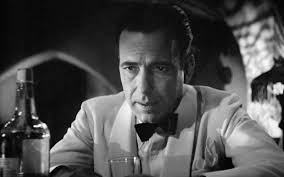
Shot mostly in sequence, Casablanca reaches its inevitable denouement as Rick makes a decision for all three of them; a decision which puts himself in harm’s way; a decision which aids and abets the escape of Victor and Ilsa from the clutches of Strasser and his cohorts. The final airport scene has been hailed as one of cinema’s greatest endings and sees Rick make a personal sacrifice of the highest order as he insists that Ilsa board the plane bound for Lisbon with Laszlo. ‘If that plane leaves the ground and you’re not with him, you’ll regret it,’ he solemnly tells her. ‘Maybe not today. Maybe not tomorrow, but soon and for the rest of your life.’ In this moment, Rick has answered the call once again and pledged his allegiance to the side which he believes has the force of morality and natural justice behind it. ‘Welcome back to the fight,’ a grateful Laszlo tells him. ‘This time I know our side will win.’
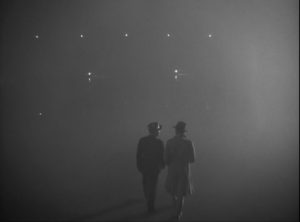
As subsequent events had it, the Allied side did eventually prevail, but no one could have been sure of such an outcome when the film was shot in 1942 and went on general release in 1943. Without dwelling on the point too much, one can detect some unmistakable propaganda running through Casablanca which is, perhaps, best epitomised by Renault as he orders his men to ’round up the usual suspects’ (in connection with Strasser’s shooting) and then disposes of a perfectly good bottle of Vichy Water. I earlier referred to the La Marseillaise scene in the bar which is also in such a vein. It’s of some note too that many of the cast of Casablanca were themselves refugees; Veidt – as I mentioned – had abandoned his own country in the 1930s; Sakall was a Jewish-Hungarian actor who left Germany in 1939; the Austrian-Hungarian Peter Lorre similarly departed a few years before this. It should come as no surprise, therefore, that many of its principals were moved to tears during the La Marseillaise scene – in which a fired-up Laszlo entreats the musicians and Free French sympathisers to drown out the sound of the singing Germans. It’s one of many indelible moments from the film. Along, of course, with that finale and the closing line – ‘Louis, I think this is the beginning of a beautiful friendship.’ Along with Curtiz’s steady direction, other contributors of note include Max Steiner – who composed the original score – and Arthur Edeson (Frankenstein, The Maltese Falcon) who served as the film’s director of photography. Nominated for a total of eight Oscars at the 16th Academy Awards, Casablanca won three for Outstanding Motion Picture, Best Director and Best Screenplay. In the acting stakes, Bogart lost out to Paul Lukas for Best Actor; Claude Rains lost in the Best Supporting Actor category to Charles Coburn; Ingrid Bergman was nominated for Best Actress for a different film – Sam Wood’s For Whom the Bell Tolls. Oft-parodied and much imitated over the years, Casablanca still represents the very apex of classic Hollywood with respect to its peerless cast, endearing story and enduring place in cinema history. Thankfully, there has never been an outright remake or a sequel. May this continue to be the case for all time. ‘We’ll always have Paris’ as that famous line from the film goes. And, fortunately, we’ll always have this paragon of good old-fashioned Hollywood film-making. Happy birthday Casablanca. Here’s looking at you as you turn 75.